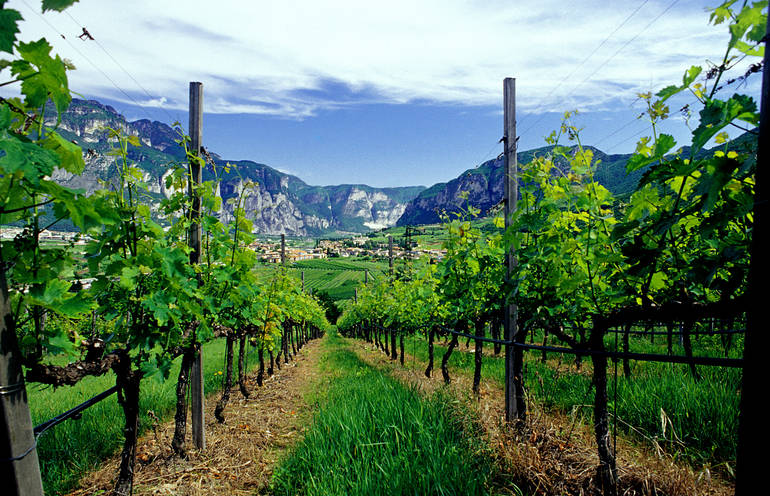An Italian grape-growing experiment shows potential for quality grape and wine production along the US East Coast.
—Robin Shreeves
The US’s first commercial wines of the Italian grape, San Marco, are officially bottled and ready for release.
A cross between Teroldego and Lagrein, San Marco was created in 1993 by Marco Stefanini at Trentino’s Foundation Edmund Mach. It gained the immediate interest of Larry Coia, co-author of Wine Grape Varieties for New Jersey and proprietor of Coia Vineyards in New Jersey, during a visit to the region nearly a decade ago. Tasting the wine, he recognized not only the cross’s potential for high quality wine production, but that the same level of quality could be achieved back home in New Jersey’s Outer Coastal Plain AVA.
“Trentino-Alto Adige has extreme temperatures,” says Coia. “It’s very hot in the summers and it’s very cold in the winters. When I looked into it, they had the same number of growing degree days, the same length of growing season, and about the same amount of rainfall as we have. The similarities were striking. And, despite the fact that they’re surrounded by calcareous mountains, they [also] have a lot of sandy loam soil.” Sandy loam soil is a defining characteristic of the Outer Coastal Plain AVA.

The Outer Coastal Plain Vineyard Association imported the vitas vinifera intraspecies cross from Italy in 2012. The vines spent the required time in quarantine at UC Davis’ Foundation Plant Services and were released for distribution in 2015.
New York’s Double A Vineyards propagated the vines, and the Rutgers New Jersey Agricultural Experiment station planted the first San Marco in New Jersey that same year. Just one year later, in 2016, Coia, along with a few other local growers, planted the new grape in their estate vineyards as well—including Bellview Winery in Landisville, NJ.
Belleview started with just three plants; in 2018, they planted an additional 65; in 2019 another 200 went in.
“We brought San Marco in for quality, but also for disease resistance,” says Jim Quarella, founder and president of Bellview. The grapes planted at the estate did not require any spraying for powdery mildew in 2021, even when the estate’s Chambourcin—another grape grown for both its quality and disease resistance—did.
However, Coia notes that the grape wasn’t bred for disease resistance—there’s been no genetic manipulation to insert genes to resist downy mildew or powdery mildew, and it is not resistant to black rot. However, unlike parents Teroldego and Lagrein, it is resistant to botrytis.
The disease resistance of San Marco is important for the maritime climate of the Outer Coastal Plain. The region experiences humid summers, often accompanied by rain—such as 2021, when the summer rains ranked the 11th wettest in New Jersey since 1895.
San Marco’s bunches are medium-sized and loose with oval-shaped berries that have deep color both in the skins and the flesh. They are moderately cold hardy, able to hold up to the cold winters of the region. The vines are fairly vigorous growth: Cane pruning is a necessity, and Coia believes that training the vines on a VSP trellis system—rather than the pergola system the Italians used for the variety—is best for the Outer Coastal Plain. He found that pergola training created over production and poorer quality fruit than VSP.

As well suited as the hybrid seems to be, there’s a bit of a “bugaboo” (as Coia puts it) when it comes to getting more San Marco vines planted.
Foundation Plant Services (FPS) recently found Grapevine Pinot Gris Virus (GPGV) and Grapevine red blotch associated virus (GRBaV) on some of the vines. Tests confirmed that about 80 percent of the New Jersey vines have GPGV, but not GRBaV. Coia reached out to his contacts in Italy and was told they’ve experienced this same issue, but has yet to affect grape quality, nor does it seem to spread to neighboring vines.
“Double A [Vineyards] does not want to grow additional San Marco until FPS will grow virus free material for us,” says Coia. “That’s not going to happen until 2023.”
Bellview aged its 2020 San Marco in neutral oak for one year and recently bottled it as a varietal wine. It is the first time any winery in the United States has offered wine produced from the grape in any form to the public. Bellview will sell its San Marco by the bottle in the tasting room for $25. Because they produced only 50 cases, it’s not offered for by-the-glass tastings.
The wine itself has a dense plum color, aromas of earth, black fruits, and spices like sage and fennel. Flavors of cherries, cranberry, and chocolate accompany well developed tannins—a promising sign of age-ability.

The Quarellas are pleased with the wine despite 2020 being a challenging growing season. The 2021 growing conditions were more favorable; the current vintage of San Marco came in at 6 tonnes an acre and 21 brix.
Despite the “bugaboo,” San Marco has real potential.
Eric Aellen, vice president and vineyard manager at Linganore Winecellars in Mt Airy, MD, sees promise in the grape as well. Linganore is the first winery outside of New Jersey to plant San Marco. Aellen is always trying to find out what works well for his vineyards. Like the Quarellas, he’s willing to experiment with grapes that are not tried and true.
Aellen stumbled across an online article about Bellview growing San Marco while researching possible new grapes and contacted the winery. “We went up to Bellview, had a lovely afternoon with Jim, and tasted through a bunch of their wines including the San Marco,” says Aellen.
He planted 750 San Marco vines this past spring at his estate, replacing several underperforming Syrah vines.
“This fall, I found two little clusters with 8 berries on them,” he says. He brought the clusters to his winemaking team to taste. “It has fresh fruit, fresh berry, a very complex middle with some nicer tannins than the Syrah had. It’s like a cross between a Syrah and a Cabernet Sauvignon. I think there’s a lot of potential there,” says Aellen.
“It’s really one of the best red grapes I’ve grown,” adds Coia about the vines in his own vineyards. “If we want to produce consistently good wine, this may be the one to bring us there.”
_______________________________________________________________________

Robin Shreeves is a drinks journalist and lifestyle features writer. Her wine writing has appeared in dozens of print and online publications including Wine Enthusiast, VinePair, Courier Post, Spirited magazine, Edible Philly, Edible Jersey, USA Today, and Drink Philly. She holds a Level 3 wine certification and Advanced Wine Speaker certification from the National Wine School. Robin is also cofounder of Thinking Outside the Bottle that offers content writing for drinks brands.
















